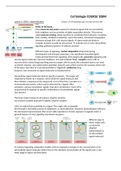Samenvatting
Cell biology summary COURSE 10
- Vak
- Cell Biology
- Instelling
- Hogeschool Arnhem En Nijmegen (HAN)
Dit is een samenvatting van de course 10 theorielessen over cel-biologie. Zelf heb ik na het leren van deze samenvatting een 8.7 gehaald voor kennistoets 1 (zonder herkansing)! This is a summary of the course 10 theory lessons on cell biology. After learning this summary, I myself obtained an 8.7 ...
[Meer zien]




